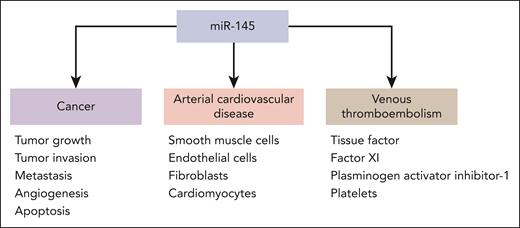In this issue of Blood, Morelli et al1 report that high plasma levels of miR-145 are associated with decreased risk of incident venous thromboembolism (VTE) in a population-based cohort study. The protective role of miR-145 indicates a potential novel target for VTE prevention.
Morelli et al used the Trøndelag Health Study (HUNT3), a population-based cohort, to determine whether circulating miR-145 plasma levels are associated with risk of incident VTE.1 MicroRNAs (miRNAs), consisting of 21 to 23 nucleotides, are endogenous and noncoding small RNAs.2 Through base pairing with target mRNAs, miRNAs regulate gene expression posttranscriptionally.2 Circulating miRNAs refer to cell-free miRNAs in body fluids, such as plasma and serum.2 Several studies have shown that plasma miRNAs may serve as a novel class of biomarkers in various diseases.2 The regulatory effect of miRNA is a heritable genetic trait.3 Several studies have linked different miRNAs to VTE but with varying results of the linked miRNAs.2,4,5 However, the study by Morelli et al is the first larger study of a circulating mRNA as a predictor for incident VTE. Instead of using an agnostic miRNA panel, the authors used a candidate miRNA (ie, miR-145).6-8 Patients with VTE have been found to have significantly lower plasma levels of miR-145 than controls.6 It has been shown that administration of miR-145 mimics in a rat model of VTE resulted in a dose-dependent reduction in thrombosis formation, which was likely mediated by downregulation of tissue factor.6 Moreover, coagulation factor XI and plasminogen activator inhibitor-1 have also been reported to be gene targets of miR-145 (see figure).6,7 Thus, accumulating evidence supports the role of miR-145 in VTE. However, before the present study, it had not been examined whether miR-145 is associated with incident VTE.1
Roles of miR-145 in cancer, arterial cardiovascular diseases, and VTE. miR-145 regulates tumor growth, angiogenesis, apoptosis, tumor invasion, and metastasis in various cancers. miR-145 affects cells involved in various arterial cardiovascular diseases: smooth muscle cells, endothelial cells, fibroblasts, and cardiomyocytes. miR-145 is now also shown to be protective against VTE, possibly because of its relationship with tissue factor, coagulation factor XI, plasminogen activator inhibitor-1, and platelets.1,6-10
Roles of miR-145 in cancer, arterial cardiovascular diseases, and VTE. miR-145 regulates tumor growth, angiogenesis, apoptosis, tumor invasion, and metastasis in various cancers. miR-145 affects cells involved in various arterial cardiovascular diseases: smooth muscle cells, endothelial cells, fibroblasts, and cardiomyocytes. miR-145 is now also shown to be protective against VTE, possibly because of its relationship with tissue factor, coagulation factor XI, plasminogen activator inhibitor-1, and platelets.1,6-10
Morelli et al showed that participants in the HUNT3 study with miR-145 levels in the highest quartile had a 49% lower risk of VTE (hazard ratio [HR], 0.51; 95% confidence interval [CI], 0.38-0.68) compared with those with miR-145 in the lowest quartile in age- and sex-adjusted analysis.1 The strongest inverse association was observed for unprovoked VTE, with an HR of 0.39 (95% CI, 0.25-0.61).1 The results were robust and did not change after adjustment for body mass index, cancer, and arterial cardiovascular disease at the study's baseline. To consider the possibility of underestimating the true association due to regression dilution bias, the authors estimated HRs of VTE as a function of time between blood sampling and VTE. The HRs of VTE by high plasma levels of miR-145 were lower with shortened time between blood sampling and VTE events.1 Nonetheless, the inverse relationship between miR-145 levels and VTE risk remained significant during the whole follow-up period of 7 years.1
Thus, Morelli and colleagues have demonstrated a robust association between miR-145 and incident VTE. What are the conclusions to be drawn from the present study? The present study indicates that miRNAs could be useful as predictors for VTE and possibly included in prediction models for VTE. The present study, together with previous human and animal studies, suggests that miR-145 overexpression might be a potential novel treatment for prevention of VTE.1,6-8 In this context, 5q− syndrome could be mediated by miR-145 and miR-146a.9 The 5q− syndrome is a subtype of myelodysplastic syndrome characterized by severe anemia and variable neutropenia but normal or high platelet counts with dysplastic megakaryocytes.9 Thus, low miR-145 might lead to prothrombotic platelet changes (see figure). Another interesting issue is that miR-145 has been linked to different malignancies and arterial cardiovascular disorders (see figure).10 This is of interest because of the linkage between VTE, cancer, and arterial vascular diseases. For example, miR-145 is downregulated in many cancers and is reported to function as a tumor suppressor.10 In the cardiovascular system, miR-145 plays multiple roles in vascular smooth muscle cells (VSMCs), endothelial cells, fibroblasts, and cardiomyocytes (see figure).10 For instance, VSMCs from miR-143/miR-145–deficient mice have lost their contractile abilities and favored neointimal lesion development. This suggests that these miRNAs play a role in VSMC phenotypic switch during injury and disease.10 This is an illustration of the fact that miRNAs often have multiple targets, which is reflected by the fact that the miRTarBase (https://mirtarbase.cuhk.edu.cn/) has accumulated >360 000 miRNA-target interactions. Moreover, because of the heritability of miRNA regulatory3 effects and the long-lasting VTE protection associated with high miR-145 levels (at least 7 years),1 the present study raises the question whether inheritance of miR-145 expression might contribute to heritability of VTE.1,3
The present study is expected to inspire researchers to identify crucial miRNAs associated with VTE, thereby improving prediction accuracy, and potentially leading to novel treatments. However, further studies are needed before the inclusion of miRNAs in prediction or diagnostic algorithms, and additional work is required before miRNA intervention becomes feasible. Nonetheless, the present study shows a robust association between miR-145 and incident VTE and suggests that further miRNA research in the field of VTE is important.
Conflict-of-interest disclosure: The author declares no competing financial interests.


This feature is available to Subscribers Only
Sign In or Create an Account Close Modal